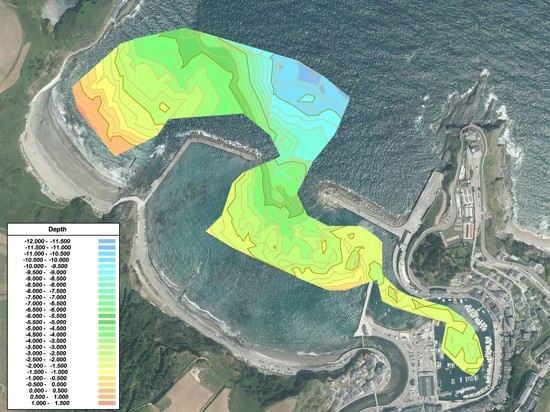Port Bathymetry Mapping Using Support Vector Machine Technique and Sentinel-2 Satellite Imagery
Abstract
1. Introduction
2. Materials and Methods
2.1. Study Sites and Data Sites
2.2. Satellite Data
2.3. Methodology
2.3.1. Pre-Processing of Satellite Images
2.3.2. Pre-Processing of Data. Generation of Comparison Bathymetry Grid
2.3.3. Bathymetry Estimation Based on Support Vector Machines
2.3.4. Data Processing
3. Results and Discussion
4. Conclusions
Author Contributions
Funding
Acknowledgments
Conflicts of Interest
References
- Strayer, D.L.; Malcom, H.M.; Bell, R.E.; Carbotte, S.M.; Nitsche, F.O. Using geophysical information to define benthic habitats in a large river. Freshw. Biol. 2006, 51, 25–38. [Google Scholar] [CrossRef]
- Brown, C.J.; Blondel, P. Developments in the application of multibeam sonar backscatter for seafloor habitat mapping. Appl. Acoust. 2009, 70, 1242–1247. [Google Scholar] [CrossRef]
- Ferretti, R.; Fumagalli, E.; Caccia, M.; Bruzzone, G. Seabed classification using a single beam echosounder. In Proceedings of the OCEANS 2015—Genova, Genoa, Italy, 18–21 May 2015. [Google Scholar]
- O’Hara Murray, R.B.; Gallego, A.G. Data review and the development of realistic tidal andwave energy scenarios for numerical modelling of Orkney Islands waters, Scotland. Ocean Coast. Manag. 2017, 147, 6–20. [Google Scholar] [CrossRef]
- KhaledSeif, A.; Kuroiwa, M.; Abualtayef, M.; Mase, H.; Matsubara, Y. A hydrodynamic model of nearshore waves and wave-induced currents. Int. J. Nav. Archit. Ocean. Eng. 2011, 3, 216–224. [Google Scholar] [CrossRef][Green Version]
- Clementi, E.; Oddo, P.; Drudi, M.; Pinardi, N.; Korres, G.; Grandi, A. Coupling hydrodynamic and wave models: First step and sensitivity experiments in the Mediterranean Sea. Ocean Dynam. 2017, 67, 1293–1312. [Google Scholar] [CrossRef]
- Tang, K.; Pradhan, B. Converting digital number into bathymetric depth: A case study over coastal and shallow Water of Langkawi Island, Malaysia. In Proceedings of the FIG Working Week, Athens, Greece, 24 January 2015. [Google Scholar]
- Mason, D.C.; Gurney, C.; Kennett, M. Beach Topography Mapping—A Comparison of Techniques. J. Coast. Conserv. 2000, 6, 113–124. [Google Scholar] [CrossRef]
- Janowski, L.; Trzcinska, K.; Tegowski, J.; Kruss, A.; Rucinska-Zjadacz, M.; Pocwiardowski, P. Nearshore Benthic Habitat Mapping Based on Multi-Frequency, Multibeam Echosounder Data Using a Combined Object-Based Approach: A Case Study from the Rowy Site in the Southern Baltic Sea. Remote Sens. 2018, 10, 1983. [Google Scholar] [CrossRef]
- Madricardo, F.; Foglini, F.; Kruss, A.; Ferrarin, C.; Pizzeghello, N.M.; Murri, C.; Rossi, M.; Bajo, M.; Bellafiore, D.; Campiani, E.; et al. High Resolution Multibeam and Hydrodynamic Datasets of Tidal Channels and Inlets of the Venice Lagoon. Sci. Data 2017, 4, 170121. [Google Scholar] [CrossRef]
- Horritt, M.S.; Bates, P.D.; Mattinson, M.J. Efects of mesh resolution and topographic representation in 2D finite volume models of shallow water fluvial flow. J. Hydrol. 2006, 329, 306–314. [Google Scholar] [CrossRef]
- Coggins, L.X.; Ghadouani, A. High-resolution bathymetry mapping of water bodies: Development and implementation. Front. Earth Sci. 2019, 7, 330. [Google Scholar] [CrossRef]
- Lyzenga, D.R.; Malinas, N.P.; Tanis, F.J. Multispectral bathymetry using a simple physically based algorithm. IEEE Trans. Geosci. Remote Sens. 2006, 44, 2251–2259. [Google Scholar] [CrossRef]
- Gao, J. Bathymetric mapping by means of remote sensing: Methods, accuracy and limitations. Prog. Phys. Geogr. 2009, 33, 103–116. [Google Scholar] [CrossRef]
- Jégat, V.; Pe’eri, S.; Freire, R.; Klemm, A.; Nyberg, J. Satellite-derived bathymetry: Performance and production. In Proceedings of the Canadian Hydrographic Conference, Halifax, NS, Cannada, 16–19 May 2016. [Google Scholar]
- Hodúl, M.; Bird, S.; Knudby, A.; Chénier, R. Satellite derived photogrammetric bathymetry. ISPRS J. Photogramm. Remote Sens. 2018, 142, 268–277. [Google Scholar] [CrossRef]
- Lyzenga, D. Passive remote sensing techniques for mapping water depth and bottom features. Appl. Opt. 1978, 17, 379–383. [Google Scholar] [CrossRef]
- Lyzenga, D. Remote sensing of bottom reflectance and ater attenuation parameters in shallow water using aircraft and Landsat data. Int. J. Remote Sens. 1981, 2, 71–82. [Google Scholar] [CrossRef]
- Van Hengel, W.; Spitzer, D. Multi-temporal water depth mapping by means of Lansat TM. Int. J. Remote Sens. 1991, 12, 703–712. [Google Scholar] [CrossRef]
- Mishra, D.; Narumalani, S.; Lawson, M.; Rundquist, D. Bathymetric mapping using IKONOS multispectral data. GISci. Remote Sens. 2004, 41, 301–321. [Google Scholar]
- Su, H.; Liu, H.; Heyman, W. Automatic derivation for bathymetric information for multispectral satellite imagery using a non-linear inversion model. Mar. Geod. 2008, 31, 281–298. [Google Scholar] [CrossRef]
- Lyons, M.; Phinn, S.; Roelfsema, C. Inegrating Quickbird multi-spectral satellite and field data: Mapping bathymetry, Seagrass Cover, Seagrass species and change in Moreton bay, Australia in 2004–2007. Remote Sens. 2011, 3, 42–64. [Google Scholar] [CrossRef]
- Misra, A.; Vojinovic, Z.; Ramakrishnan, B.; Luijendijk, A.; Ranasinghe, R. Shallow water bathymetry mapping using Support Vector Machine (SVM) technique and multispectral imagery. Int. J. Remote Sens. 2018, 39, 4431–4450. [Google Scholar] [CrossRef]
- Caballero, I. Assessment of a multi-scene approach with sentinel-2A/B imagery to estimate satellite-derived Bathymetry over moderately turbid regions. In Proceedings of the Poster Presented at the Living Planet Symposium, Milan, Italy, 13–17 May 2019. [Google Scholar]
- Traganos, D.; Poursanidis, D.; Aggarwal, B.; Chrysoulakis, N.; Einartz, P. Estimating satellite-derived bathymetry (SDB) with the google earth engine and sentinel-2. Remote Sens. 2018, 10, 859. [Google Scholar] [CrossRef]
- Drusch, M.; Del Bello, U.; Carlier, S.; Colin, O.; Fernandez, V.; Gascon, F.; Hoersch, B.; Isola, C.; Laberinti, P.; Martimort, P. Sentinel-2: ESA’s Optical High-Resolution Mission for GMES Operational Services. Remote Sens. Environ. 2012, 120, 25–36. [Google Scholar] [CrossRef]
- Caballero, I.; Stumpf, R.P.; Meredith, A. Preliminary assessment of turbidity and chlorophyll impact on bathymetry derived from sentinel-2a and sentinel-3a satellites in south florida. Remote Sens. 2019, 11, 645. [Google Scholar] [CrossRef]
- Almar, R.; Kestenare, E.; Reyns, J.; Jouanno, J.; Anthony, E.; Laibi, R.; Hemer, M.; Du, Y.; Ranasinghe, R. Response of the Bight of Benin (Gulf of Guinea, West Africa) coastline to anthropogenic and natural forcing, part1: Wave climate variability and impacts on the longshore sediment transport. Cont. Shelf Res. 2015, 110, 48–59. [Google Scholar] [CrossRef]
- Bergsma, E.W.; Almar, R.; de Almeida, L.P.M.; Sall, M. On the operational use of uavs for video-derived bathymetry. Coast. Eng. 2019, 152, 103527. [Google Scholar] [CrossRef]
- Liu, S.; Gao, Y.; Zheng, W.; Xiaolu, L. Performance of Two Neural Network Models in Bathymetry. Remote Sens. Lett. 2015, 6, 321–330. [Google Scholar] [CrossRef]
- Wang, Y.; Zhang, P.; Dong, W.; Zhang, Y. Study on Remote Sensing of Water Depths Based on BP Artificial Neural Network. Mar. Sci. Bull. 2007, 9, 26–35. [Google Scholar]
- Ceyhun, Ö.; Yalçın, A. Remote sensing of water depths in shallow waters via artificial neural networks. Estuar. Coast. Shelf. Sci. 2010, 89, 89–96. [Google Scholar] [CrossRef]
- El-Mewafi, M.; Salah, M.; Fawzi, B. Assessment of Optical Satellite Images for Bathymetry Estimation in Shallow Areas Using Artificial Neural Network Model. Am. J. Geogr. Inf. Syst. 2018, 7, 99–106. [Google Scholar]
- Wang, L.; Liu, H.; Su, H.; Wang, J. Bathymetry retrieval from optical images with spatially distributed support vector machines. GISci. Remote Sens. 2019, 56, 323–337. [Google Scholar] [CrossRef]
- Muzirafuti, E.-A.; Barreca, G.; Crupi, A.; Faina, G.; Paltrinieri, D.; Lanza, S.; Randazzo, G. The Contribution of Multispectral Satellite Image to Shallow Water Bathymetry Mapping on the Coast of Misano Adriatico, Italy. J. Mar. Sci. Eng. 2016, 8, 126. [Google Scholar] [CrossRef]
- European Space Agency. European Space Agency, 2019b. ESA Sentinel 2 Orbit Description. Available online: https://sentinel.esa.int/web/sentinel/missions/sentinel-2/satellite-description/orbit (accessed on 29 September 2019).
- European Space Agency. Sentinel-2 MSI Technical Guide. Available online: https://earth.esa.int/web/sentinel/technical-guides/sentinel-2-msi (accessed on 10 September 2019).
- Nowakowski, T. Arianespace Successfully Launches Europe’s Sentinel-2A Earth Observation Satellite; Spaceflight insider: Kourou, French Guiana, 2015. [Google Scholar]
- Kaplan, G.; Avdan, U. Object-based water body extraction model using Sentinel-2 satellite imagery. Eur. J. Remote Sens. 2017, 50, 137–143. [Google Scholar] [CrossRef]
- Poursanidis, D.; Traganos, D.; Reinartz, P.; Chrysoulakis, N. On the use of Sentinel-2 for coastal habitat mapping and satellite-derived bathymetry estimation using downscaled coastal aerosol band. Int. J. Appl. Earth Obs. 2019, 80, 58–70. [Google Scholar] [CrossRef]
- Lanaras, C.; Bioucas-Dias, J.; Galliani, S.; Baltsavias, E.; Schindler, K. Super-resolution of Sentinel-2 images: Learning a globally applicable deep neural network. ISPRS J. Photogramm. 2018, 146, 305–319. [Google Scholar] [CrossRef]
- ESA SNAP. Available online: https://step.esa.int/main/toolboxes/snap (accessed on 12 October 2019).
- Stumpf, R.P.; Holderied, K.; Sinclair, M. Determination of Water Depth with High- Resolution Satellite Imagery over Variable Bottom Types. Limnol. Oceanogr. 2003, 48, 547–556. [Google Scholar] [CrossRef]
- Vapnik, V.; Golowich, S.E.; Smola, A. Support vector method for function approximation, regression estimation, and signal processing. In Advances in Neural Information Processing Systems; MIT Press: Cambridge, MA, USA, 1997; pp. 281–287. [Google Scholar]
- Clarke, S.M.; Griebsch, J.H.; Simpson, T.W. Analysis of support vector regression for approximation of complex engineering analyses. J. Mech. Des. Trans. ASME 2005, 12, 1077–1087. [Google Scholar] [CrossRef]
- Bishop, C.M. Pattern Recognition and Machine Learning; Springer: Berlin, Germany, 2006. [Google Scholar]
- Kranjčić, N.; Medak, D.; Župan, R.; Rezo, M. Support Vector Machine Accuracy Assessment for Extracting Green Urban Areas in Towns. Remote Sens. 2019, 11, 655. [Google Scholar]
- Kuhn, M. Classification and regression training. In R Package Version 6.0–24; 2014; Available online: https://ui.adsabs.harvard.edu/abs/2015ascl.soft05003K/abstract (accessed on 26 June 2020).
- Parameswaran, S.; Weinberger, K.Q. Large margin multi-task metric learning. In Advances in Neural Information Processing Systems; Curran Associates Inc.57: Red Hook, NY, USA, 2010; pp. 1867–1875. [Google Scholar]
- Verrelst, J.; Muñoz, J.; Alonso, L.; Delegido, J.; Rivera, J.P.; Camps-Valls, G.; Moreno, J. Machine learning regression algorithms for biophysical parameter retrieval: Opportunities for Sentinel-2 and -3. Remote Sens. Environ. 2012, 118, 127–139. [Google Scholar] [CrossRef]
- Cowan, G. Statistical Data Analysis; Oxford University Press: Oxford, UK, 1998. [Google Scholar]
- Benveniste, J.; Cazenave, A.; Vignudelli, S.; Fenoglio-Marc, L.; Shah, R.; Almar, R.; Andersen, O.; Birol, F.; Bonnefond, P.; Bouffard, J.; et al. Requirements for a Coastal Hazards Observing System. Front. Mar. Sci. 2019, 6, 348. [Google Scholar] [CrossRef]
- Geyman, E.C.; Maloof, A.C. A simple method for extracting water depth from multispectral satellite imagery in regions of variable bottom type. Earth Space Sci. 2019, 6, 527–537. [Google Scholar] [CrossRef]
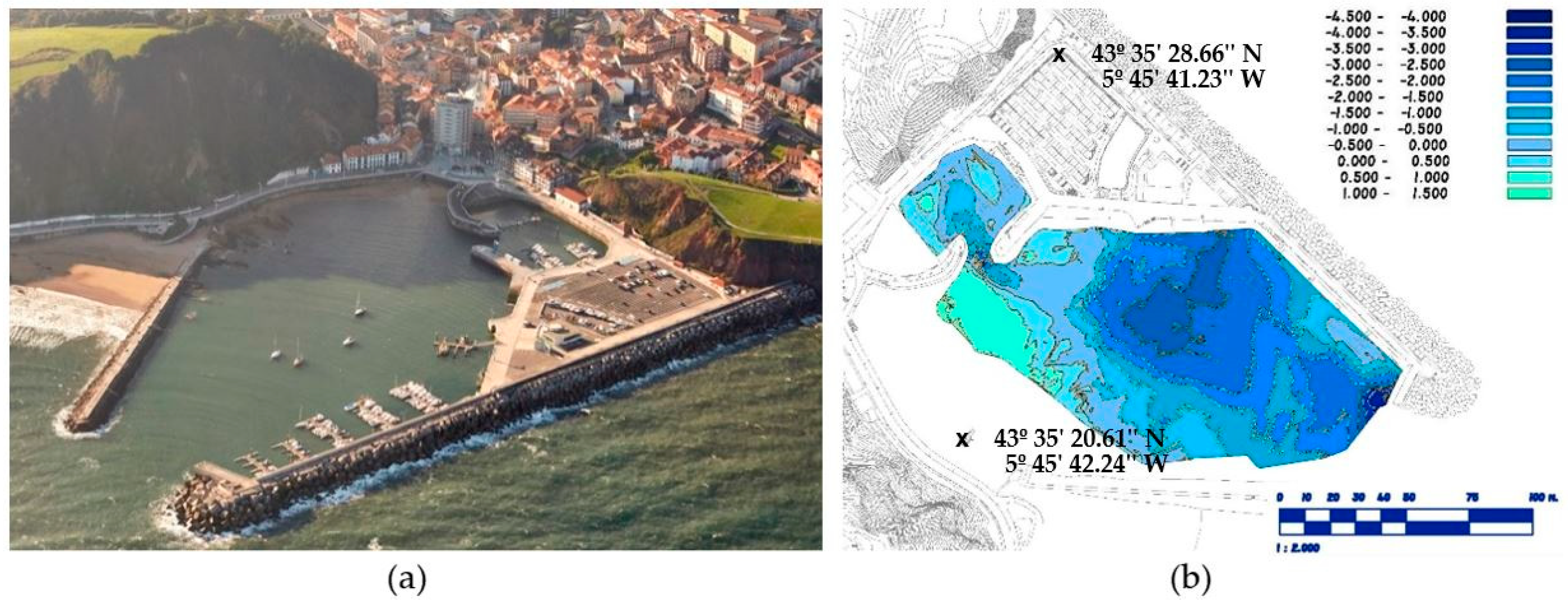
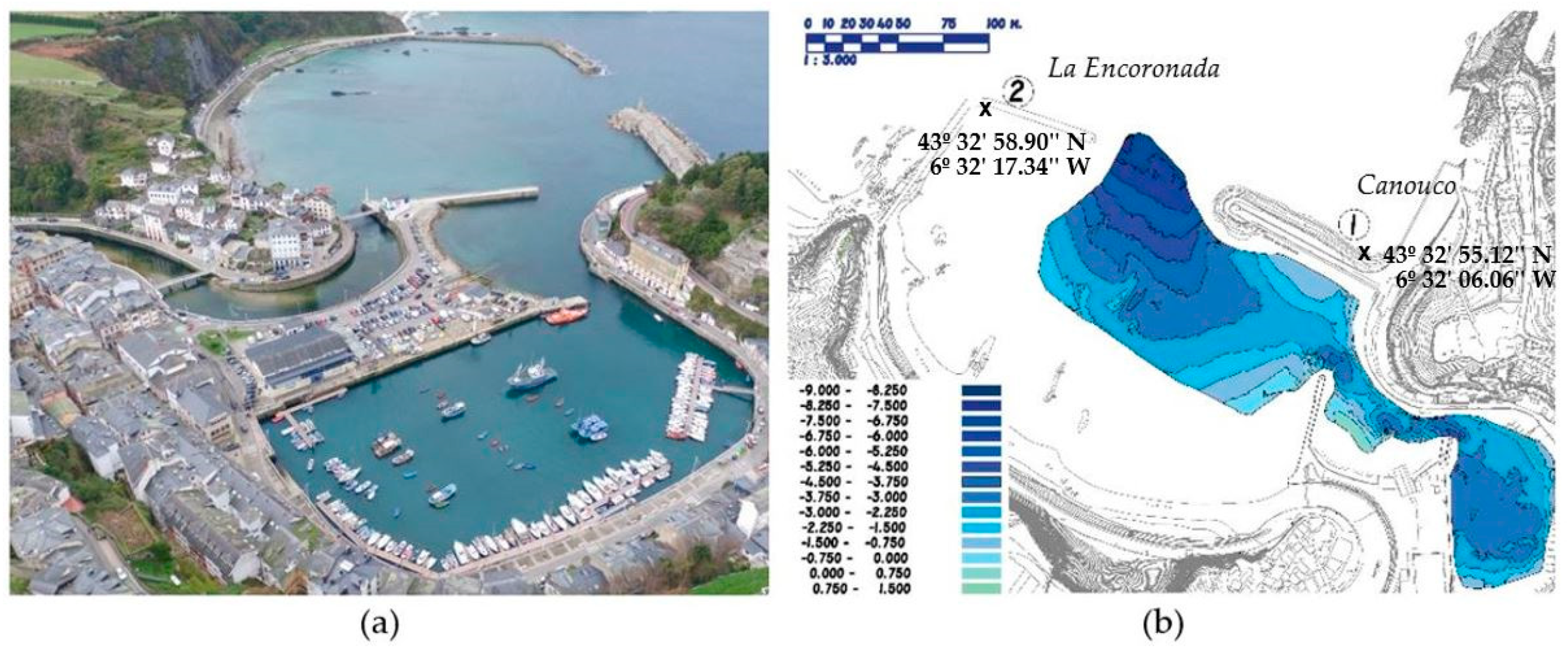
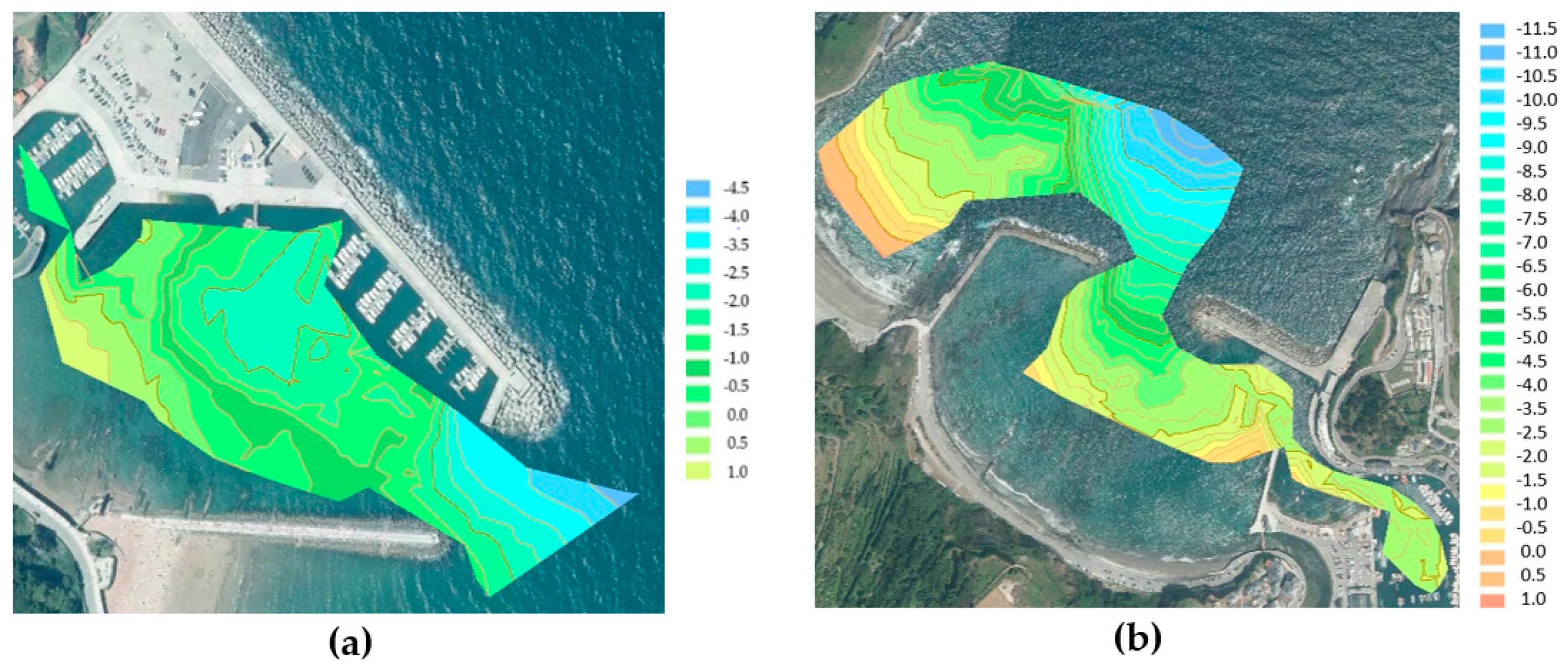
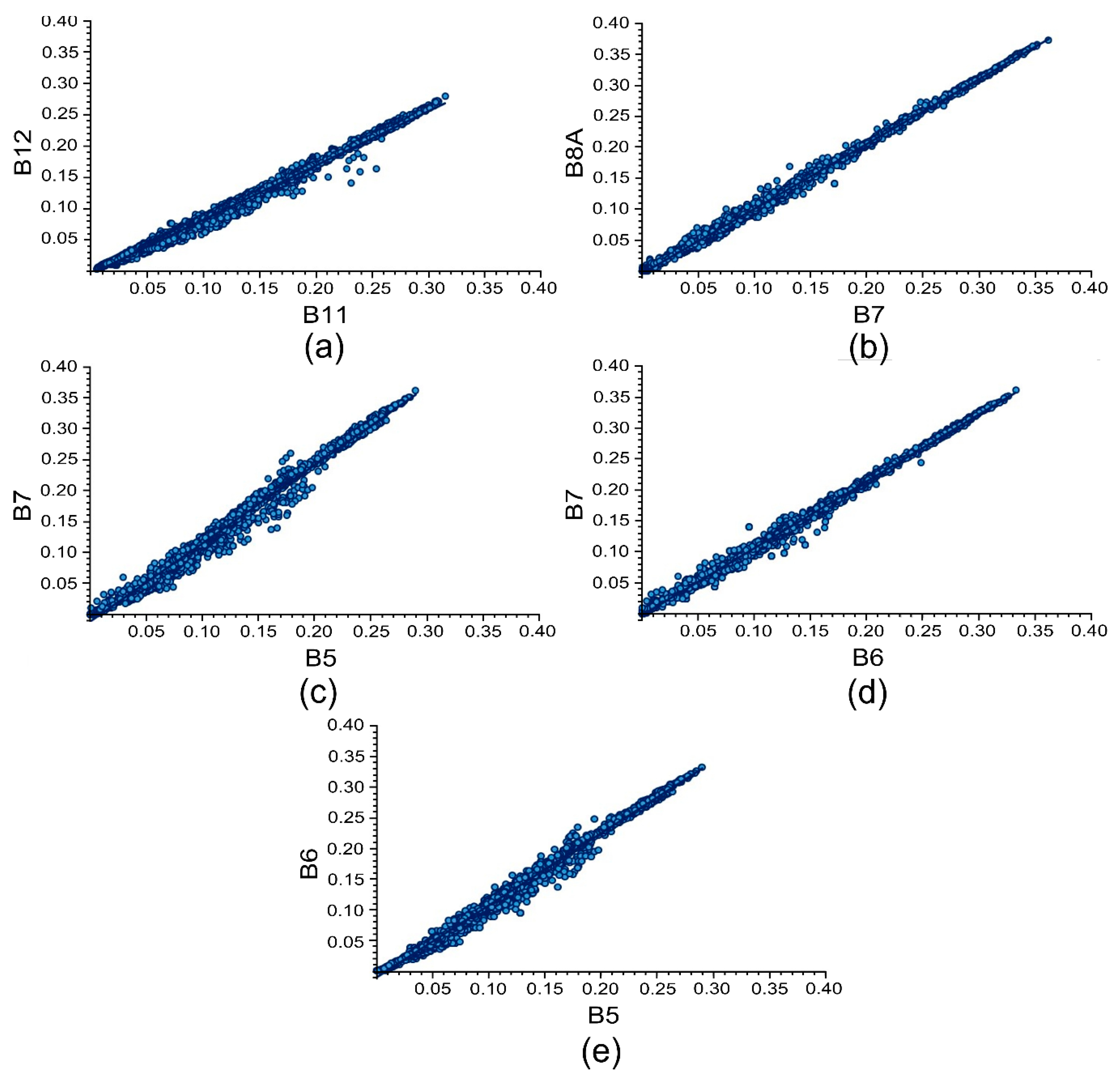
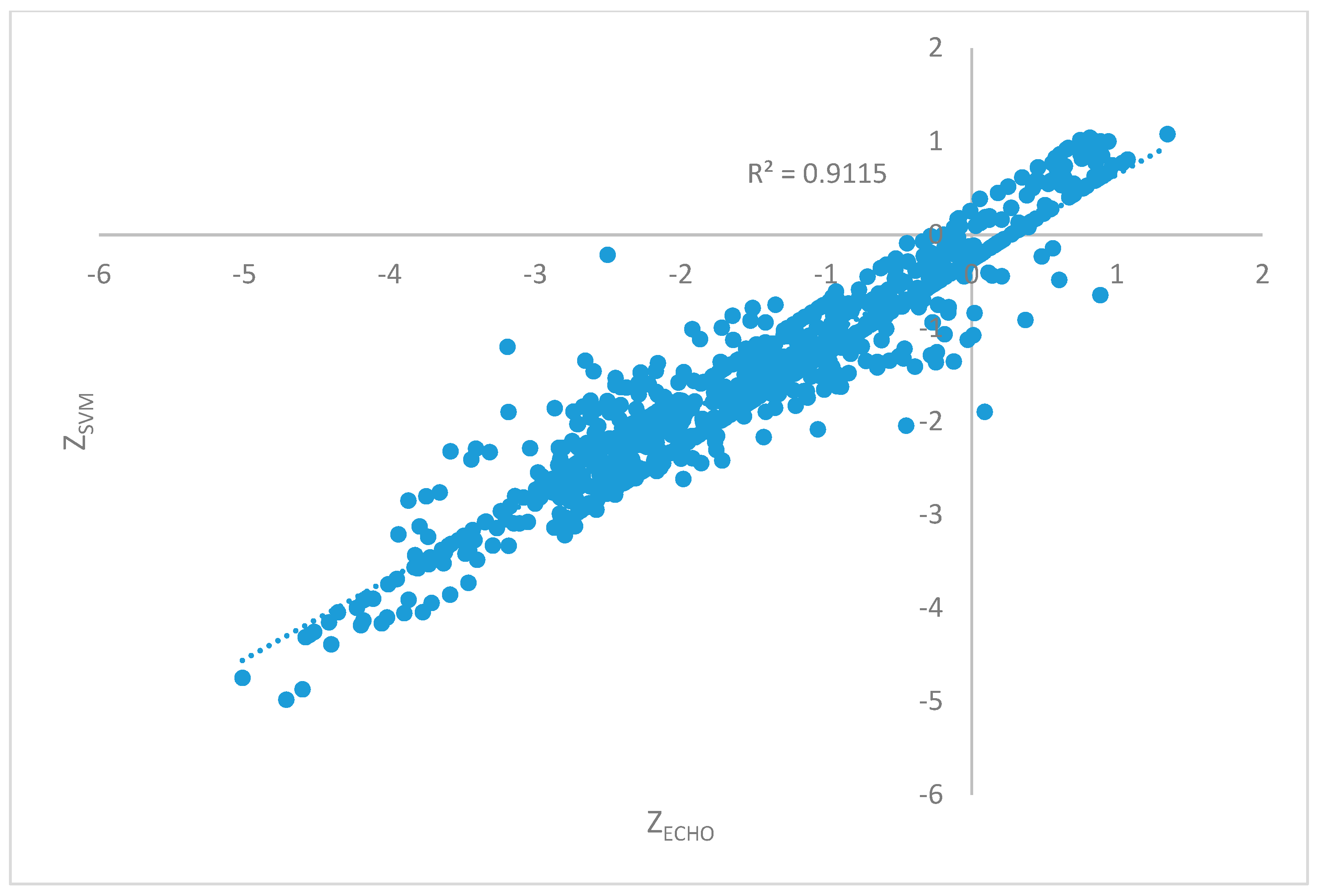
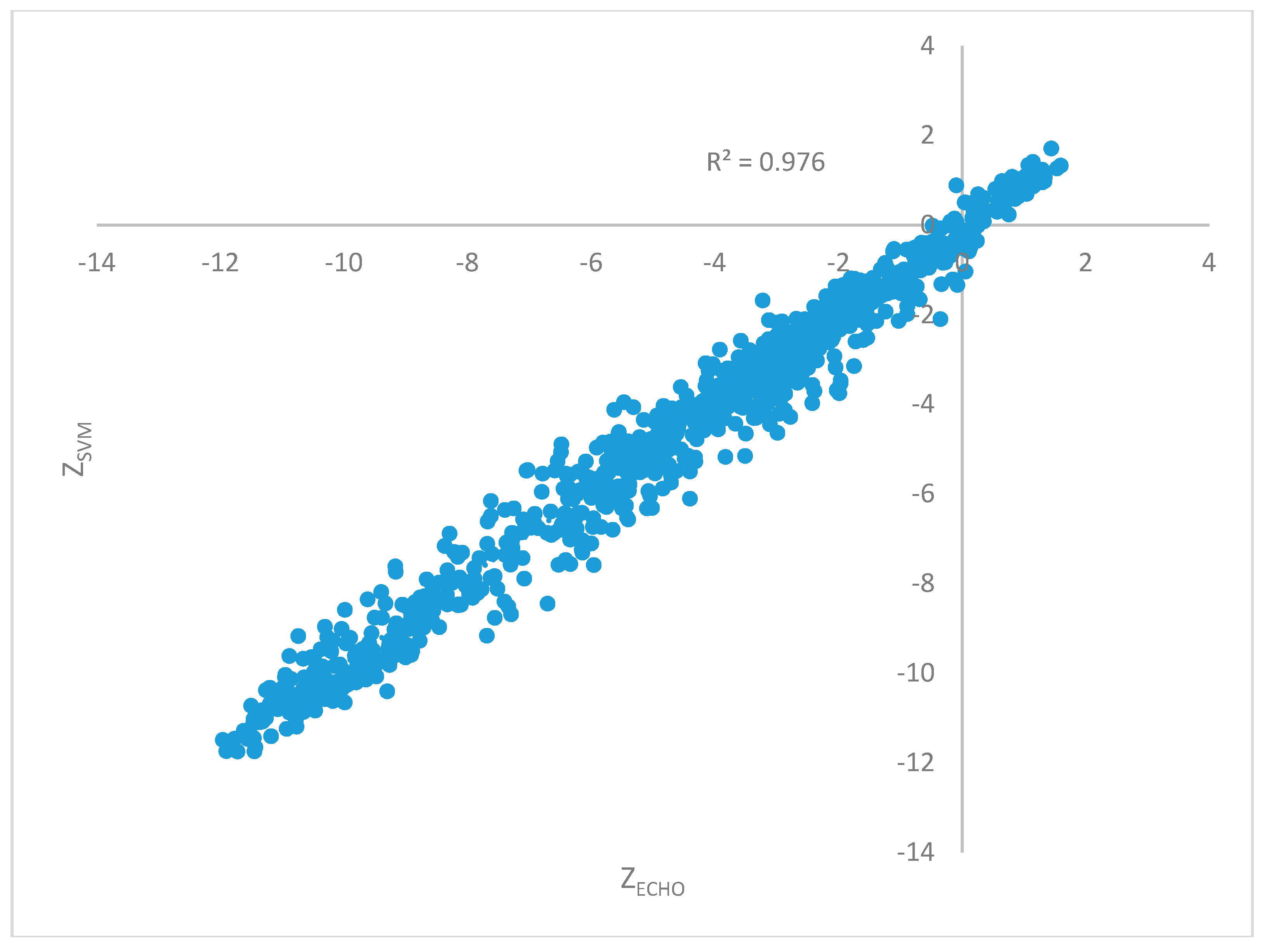
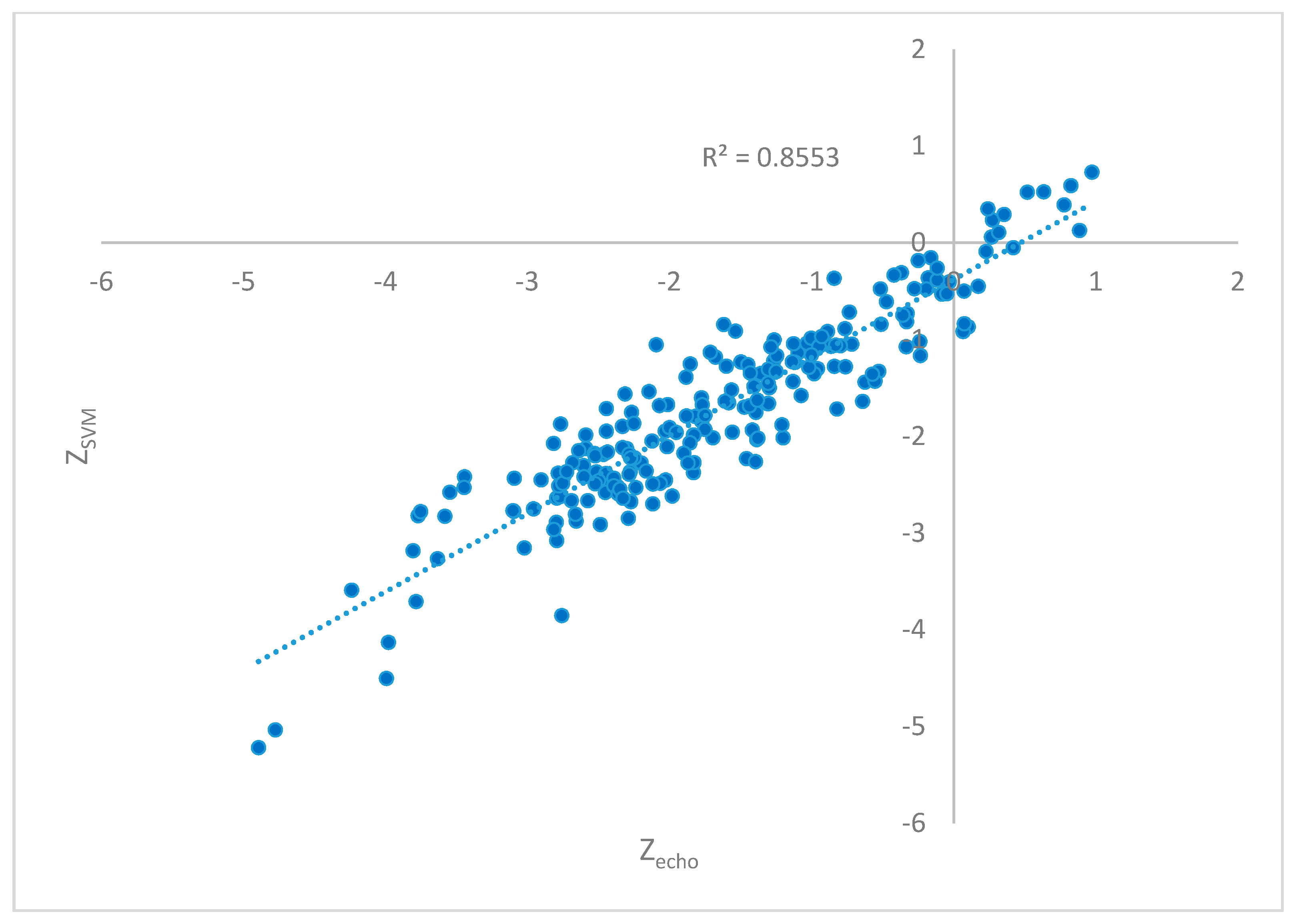
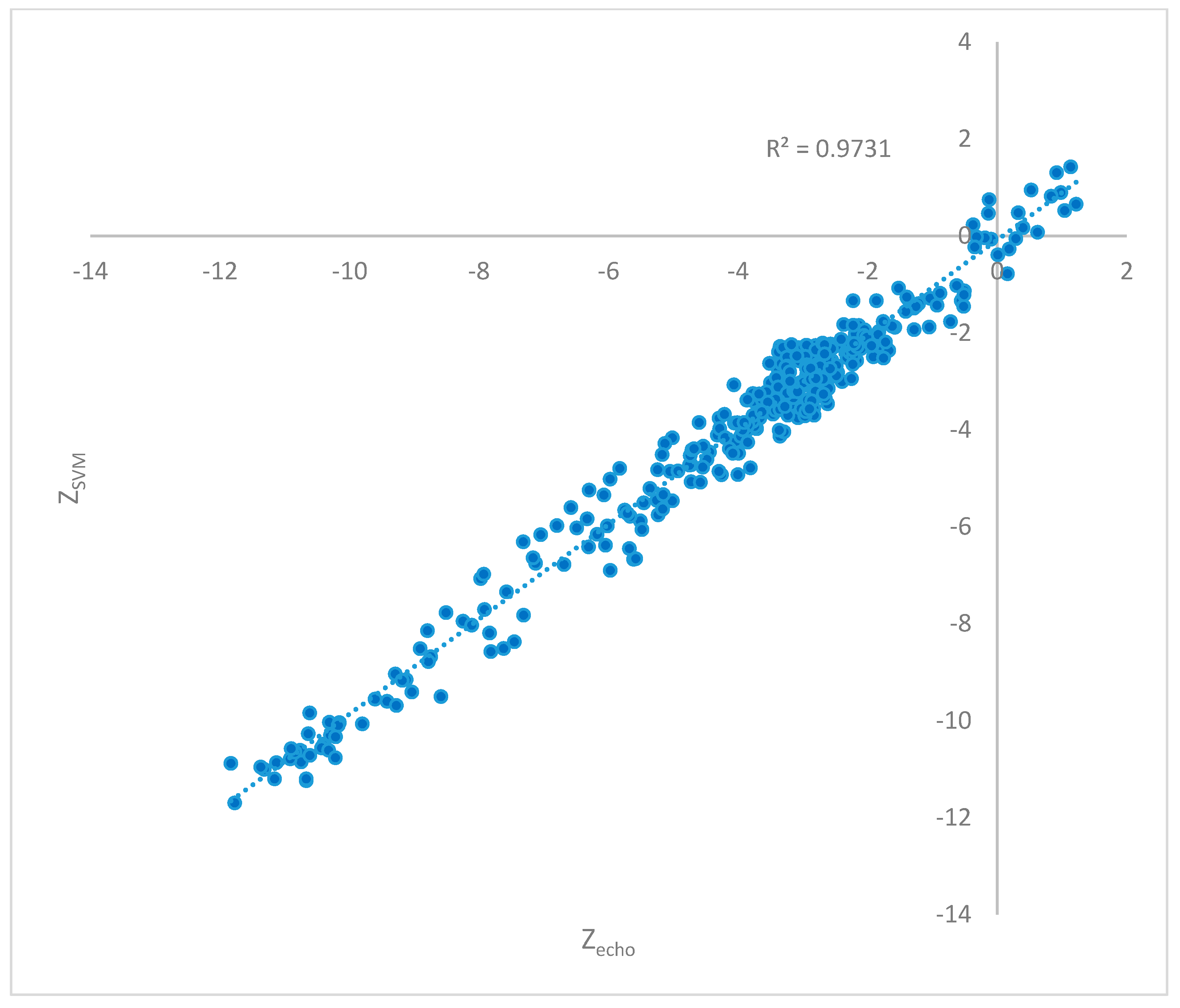
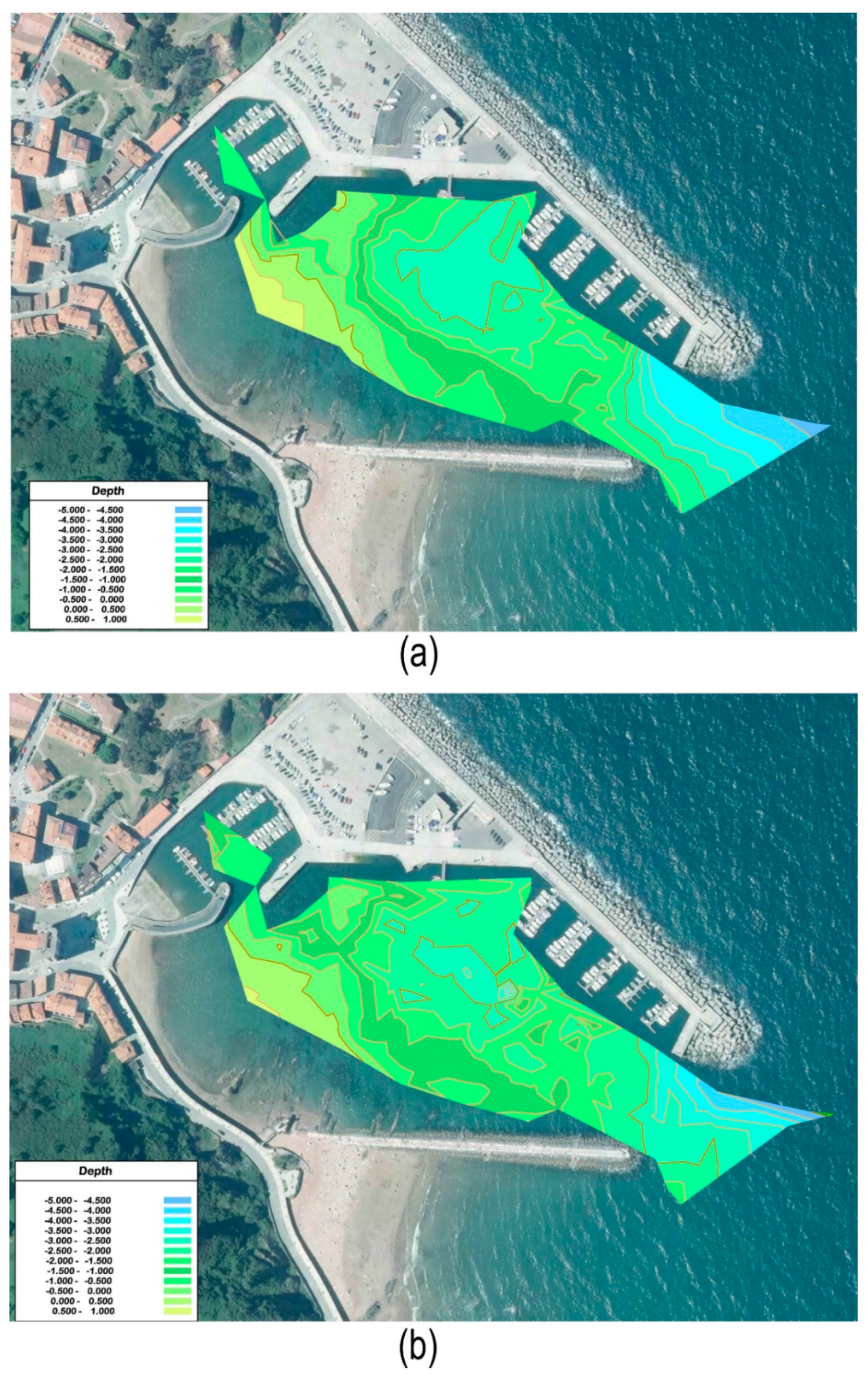

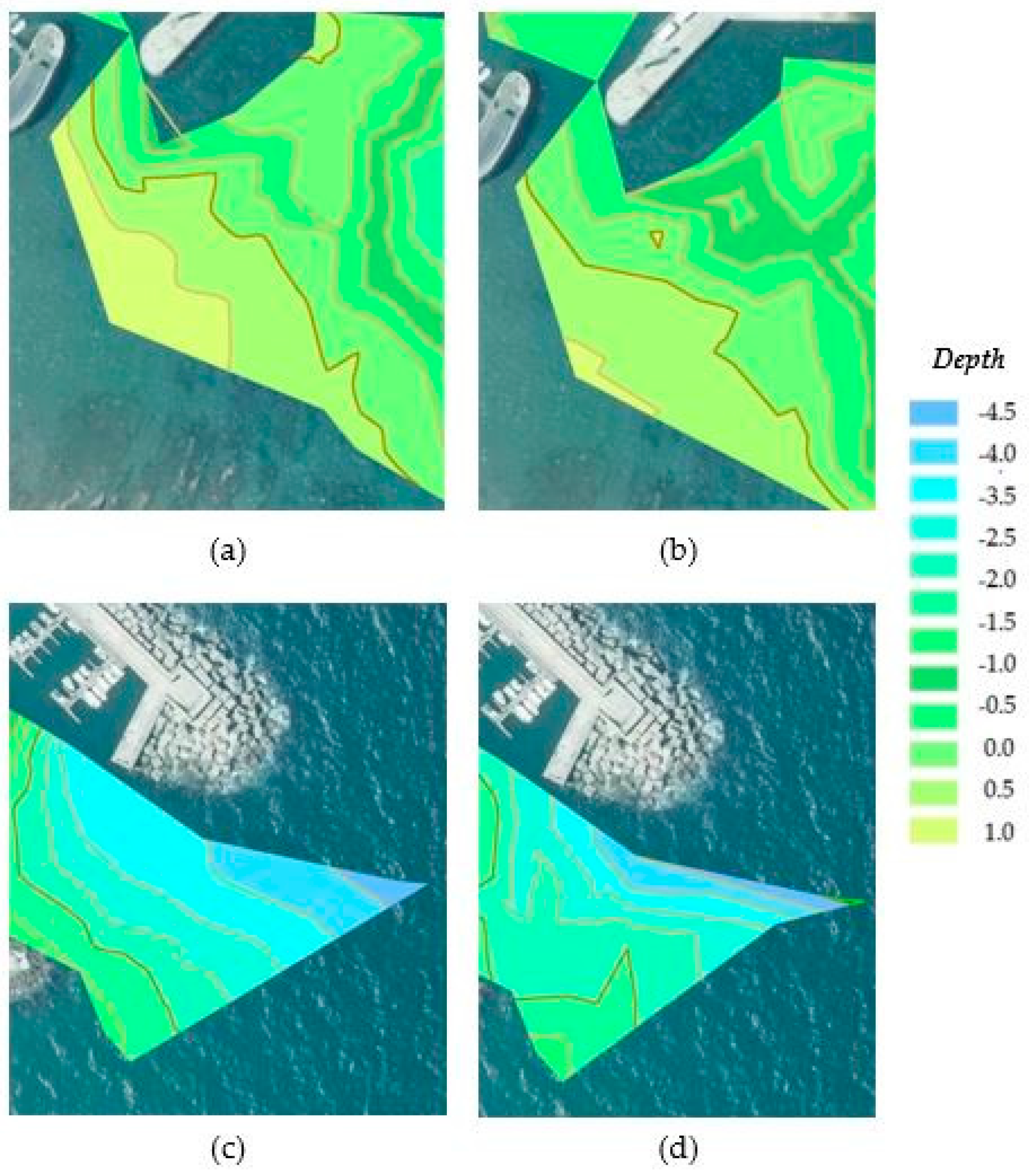
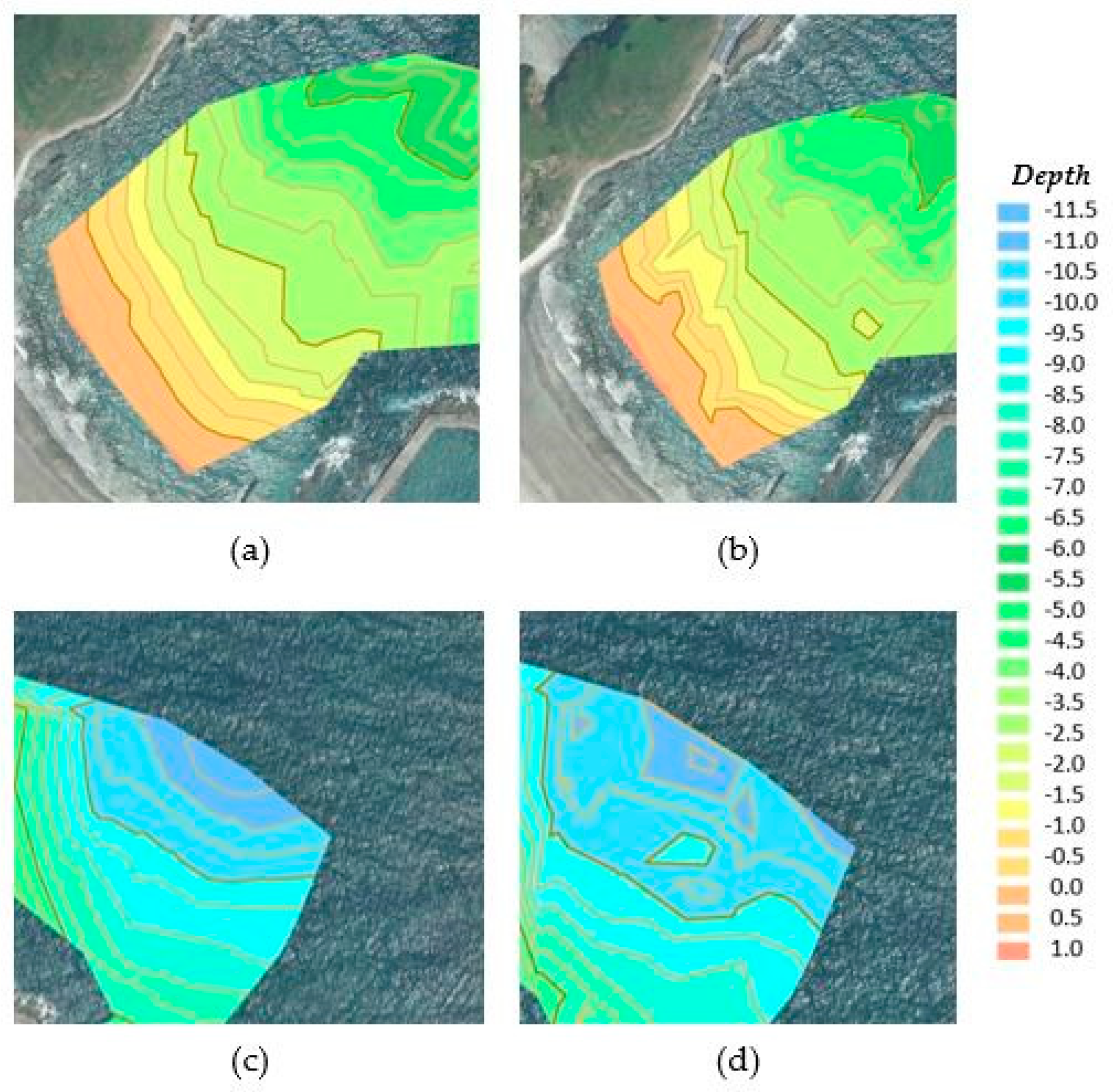
| Dates of Acquisition | ||
|---|---|---|
| In Situ | Sentinel-2 | |
| Candás | 16 October 2016 12 March 2018 29 April 2019 | 03 November 2016 16 March 2018 22 April 2019 |
| Luarca | 28 June 2016 10 May 2018 28 May 2019 | 29 June 2016 10 May 2018 30 May 2019 |
| Band | Spectral Region | Resolution [m] | Central Wavelength [nm] |
|---|---|---|---|
| B1 | Coastal aerosol | 60 | 443 |
| B2 | Blue | 10 | 490 |
| B3 | Green | 10 | 560 |
| B4 | Red | 10 | 665 |
| B5 | Vegetation red edge | 20 | 705 |
| B6 | Vegetation red edge | 20 | 740 |
| B7 | Vegetation red edge | 20 | 783 |
| B8 | NIR | 10 | 842 |
| B8A | Narrow NIR | 20 | 865 |
| B9 | Red Edge | 60 | 940 |
| B10 | Water vapor | 60 | 1375 |
| B11 | SWIR–Cirrus | 20 | 1610 |
| B12 | SWIR | 20 | 2190 |
| Port | Training | Testing |
|---|---|---|
| Candás | 1092 | 284 |
| Luarca | 1593 | 388 |
| Band | B1 | B2 | B3 | B4 | B5 | B6 | B7 | B8 | B8A | B9 | B11 | B12 |
|---|---|---|---|---|---|---|---|---|---|---|---|---|
| B1 | ||||||||||||
| B2 | 0.96 | |||||||||||
| B3 | 0.89 | 0.98 | ||||||||||
| B4 | 0.85 | 0.95 | 0.99 | |||||||||
| B5 | 0.82 | 0.9 | 0.95 | 0.97 | ||||||||
| B6 | 0.83 | 0.91 | 0.96 | 0.97 | 1 | |||||||
| B7 | 0.82 | 0.9 | 0.95 | 0.97 | 0.99 | 1 | ||||||
| B8 | 0.81 | 0.92 | 0.97 | 0.99 | 0.97 | 0.98 | 0.98 | |||||
| B8A | 0.81 | 0.9 | 0.95 | 0.97 | 0.99 | 1 | 1 | 0.98 | ||||
| B9 | −0.04 | 0.06 | 0.22 | 0.27 | 0.36 | 0.34 | 0.33 | 0.31 | 0.34 | |||
| B11 | 0.74 | 0.84 | 0.9 | 0.94 | 0.98 | 0.98 | 0.98 | 0.96 | 0.98 | 0.38 | ||
| B12 | 0.72 | 0.82 | 0.89 | 0.93 | 0.97 | 0.97 | 0.98 | 0.95 | 0.99 | 0.39 | 1 |
| Port | Max Depth [m] | Min Depth [m] | Mean Depth [m] |
|---|---|---|---|
| Candás | 1.3461 | −5.0149 | −1.5519 |
| Luarca | 1.5979 | −11.9601 | −4.0694 |
| Port | R2 | MAE [m] | RMSE [m] |
|---|---|---|---|
| Candás | 0.911 | 0.2779 | 0.3694 |
| Luarca | 0.976 | 0.3274 | 0.4409 |
| Port | R2 | MAE [m] | RMSE [m] |
|---|---|---|---|
| Candás | 0.8553 | 0.3421 | 0.4370 |
| Luarca | 0.9731 | 0.3678 | 0.4640 |
| Training Dataset | Testing Dataset | |||
|---|---|---|---|---|
| Port | Relative Error [%] | Relative Error Range Depth [%] | Relative Error [%] | Relative Error Range Depth [%] |
| Candás | 17.90% | 8.74% | 22.05% | 10.76% |
| Luarca | 8.05% | 4.83% | 9.04% | 5.43% |
© 2020 by the authors. Licensee MDPI, Basel, Switzerland. This article is an open access article distributed under the terms and conditions of the Creative Commons Attribution (CC BY) license (http://creativecommons.org/licenses/by/4.0/).
Share and Cite
Mateo-Pérez, V.; Corral-Bobadilla, M.; Ortega-Fernández, F.; Vergara-González, E.P. Port Bathymetry Mapping Using Support Vector Machine Technique and Sentinel-2 Satellite Imagery. Remote Sens. 2020, 12, 2069. https://doi.org/10.3390/rs12132069
Mateo-Pérez V, Corral-Bobadilla M, Ortega-Fernández F, Vergara-González EP. Port Bathymetry Mapping Using Support Vector Machine Technique and Sentinel-2 Satellite Imagery. Remote Sensing. 2020; 12(13):2069. https://doi.org/10.3390/rs12132069
Chicago/Turabian StyleMateo-Pérez, Vanesa, Marina Corral-Bobadilla, Francisco Ortega-Fernández, and Eliseo P. Vergara-González. 2020. "Port Bathymetry Mapping Using Support Vector Machine Technique and Sentinel-2 Satellite Imagery" Remote Sensing 12, no. 13: 2069. https://doi.org/10.3390/rs12132069
APA StyleMateo-Pérez, V., Corral-Bobadilla, M., Ortega-Fernández, F., & Vergara-González, E. P. (2020). Port Bathymetry Mapping Using Support Vector Machine Technique and Sentinel-2 Satellite Imagery. Remote Sensing, 12(13), 2069. https://doi.org/10.3390/rs12132069






